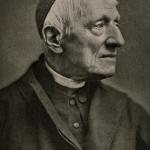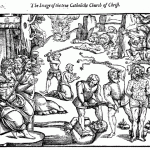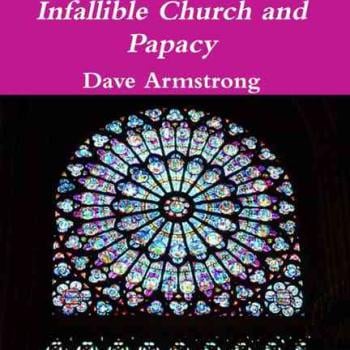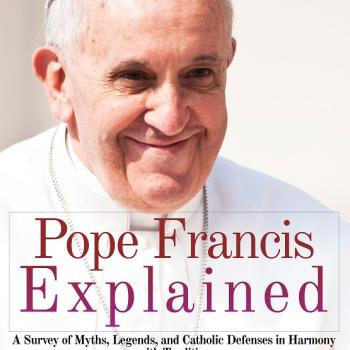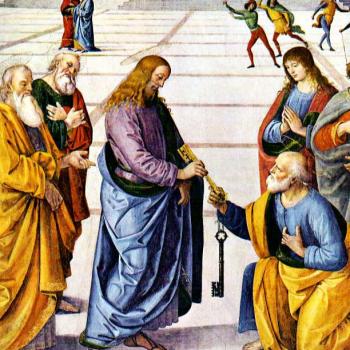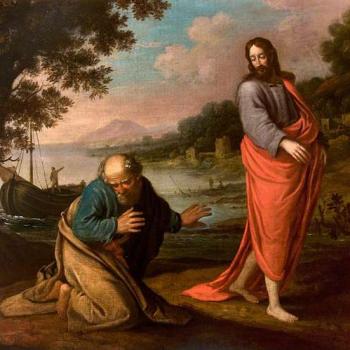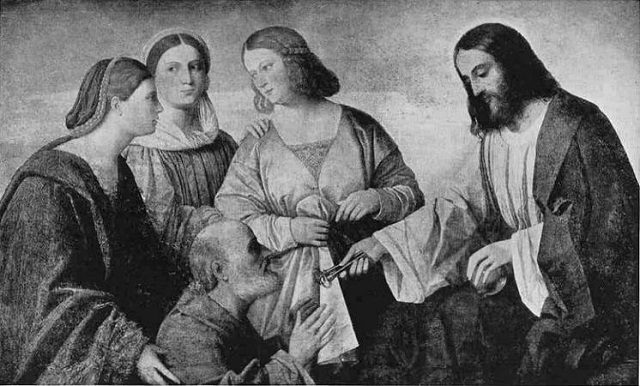
[From the 1994 early manuscript (750 page) version of my first book, A Biblical Defense of Catholicism]
****
1. Peter as the “Rock” (Matthew 16:18)
Matthew 16:18 “And I say also unto thee, That thou art Peter, and upon this rock I will build my church; and the gates of hell shall not prevail against it.”
A. New Bible Dictionary
“. . . That the rock is Peter himself . . . is found almost as early as the other [interpretation], for Tertullian and the bishop, whether Roman or Carthaginian, against whom he thundered in De Pudicitia, assume this, though with different inferences. Its strength lies in the fact that Mt 16:19 is in the singular, and must be addressed directly to Peter . . . Many Protestant interpreters, including notably Cullmann, take the latter view.” (4: 972)
B. Word Studies in the New Testament (Vincent)
“The word refers neither to Christ as a rock, distinguished from Simon, a stone, nor to Peter’s confession, but to Peter himself, . . . The reference of `petra’ to Christ is forced and unnatural. The obvious reference of the word is to Peter. The emphatic this naturally refers to the nearest antecedent; and besides, the metaphor is thus weakened, since Christ appears here, not as the foundation, but as the architect: `On this rock will I build.’ Again, Christ is the great foundation, the `chief cornerstone,’ but the New Testament writers recognize no impropriety in applying to the members of Christ’s church certain terms which are applied to him. For instance, Peter himself (1 Pet 2:4), calls Christ a living stone, and in ver. 5, addresses the church as living stones . . .
“Equally untenable is the explanation which refers `petra’ to Simon’s confession. Both the play upon the words and the natural reading of the passage are against it, and besides, it does not conform to the fact, since the church is built, not on confessions, but on confessors – living men . . .
“The reference to Simon himself is confirmed by the actual relation of Peter to the early church . . . See Acts 1:15; 2:14,37; 3:2; 4:8; 5:15,29; 9:34,40; 10:25-6; Gal 1:18.” (11; v.1: 91-92)
C. Encyclopaedia Britannica (1985)
“Though in the past some authorities have considered that the term rock refers to Jesus himself or to Peter’s faith, the consensus of the great majority of scholars today is that the most obvious and traditional understanding should be construed, namely, that rock refers to the person of Peter.” (1)
D. Wycliffe Bible Commentary
“Another view common among some Protestants (Alford, Broadus, Vincent) is that Peter . . . is the rock.” (7: 959)
E. New Bible Commentary
“Some interpreters have . . . referred to Jesus as the rock here, but the context is against this. Nor is it likely that Peter’s faith or Peter’s confession is meant. It is undoubtedly Peter himself who is to be the rock, but Peter confessing, faithful and obedient . . . The leading role which Peter played is shown throughout the early chapters of Acts.” (6: 837)
F. Anchor Bible (William F. Albright and C. S. Mann)
“In view of the background of verse 19 . . . one must dismiss as confessional interpretation [i.e., biased by denominational views] any attempt to see this rock as meaning the faith, or the Messianic confession of Peter . . . The general sense of the passage is indisputable . . . Peter is the rock on which the new community will be built, and in that community, Peter’s authority to `bind’ or `release’ will be a carrying out of decisions made in heaven. His teaching and disciplinary activities will be similarly guided by the Spirit to carry out Heaven’s will.” (2)
G. Robert McAfee Brown
“Protestants are learning that the crucial passage in Matthew 16 about the `rock’ on which the church will be built almost certainly refers to Peter himself rather than to his faith.” (3)
H. Tyndale New Testament Commentaries (R. T. France)
“Jesus now sums up Peter’s significance in a name, Peter . . .It describes not so much Peter’s character (he did not prove to be `rock-like’ in terms of stability or reliability), but his function, as the foundation-stone of Jesus’ church. The feminine word for `rock’, `petra’, is necessarily changed to the masculine `petros’ (stone) to give a man’s name, but the word-play is unmistakable (and in Aramaic would be even more so, as the same form `kepha’ would occur in both places). It is only Protestant overreaction to the Roman Catholic claim . . . that what is here said of Peter applies also to the later bishops of Rome, that has led some to claim that the `rock’ here is not Peter at all but the faith which he has just confessed. The word-play, and the whole structure of the passage, demands that this verse is every bit as much Jesus’ declaration about Peter as v.16 was Peter’s declaration about Jesus . . . It is to Peter, not to his confession, that the rock metaphor is applied . . .
“Peter is to be the foundation-stone of Jesus’ new community . . . which will last forever.” (4)
I. Expositor’s Bible Commentary (D. A. Carson)
“On the basis of the distinction between `petros’ . . . and `petra’ . . . , many have attempted to avoid identifying Peter as the rock on which Jesus builds his church. Peter is a mere`stone,’ it is alleged; but Jesus himself is the `rock’ . . . Others adopt some other distinction . . . Yet if it were not for Protestant reactions against extremes of Roman Catholic interpretation, it is doubtful whether many would have taken `rock’ to be anything or anyone other than Peter . . .
“The Greek makes the distinction between `petros’ and `petra’ simply because it is trying to preserve the pun, and in Greek the feminine “petra’ could not very well serve as a masculine name . . .
“Had Matthew wanted to say no more than that Peter was a stone in contrast with Jesus the Rock, the more common word would have been `lithos’ )`stone’ of almost any size). Then there would have been no pun – and that is just the point! . . .
“In this passage Jesus is the builder of the church and it would be a strange mixture of metaphors that also sees him within the same clauses as its foundation . . .” (5)
J. Peter in the New Testament
“Precisely because of the Aramaic identity of `Kepha’/`kepha’, there can be no doubt that the rock on which the church was to be built was Peter. Is this true also for Matthew in whose Greek there is the slight difference `Petros’/`petra’? Probably the most common view would be that it is . . . It would be pointless to list all the commentaries holding this view, but it is found in [a] popular one-volume commentary . . . ; K. Stendahl in Peake’s Commentary on the Bible (2nd rev. ed.; London: Nelson, 1962), p.787.” (6)
K. Richard Baumann
“Luther . . . took his rejection of the Petrine office from his erroneous interpretation of Christ’s saying in Matthew 16 . . . But today we recognize Luther’s error and give it up. `Anti-Catholic polemic has done violence to the Lord’s saying because it defines the Rock upon which Jesus builds His community not as Peter but as his faith and confession . . . What is spoken of, however, in Matthew 16 is the man to whom Jesus entrusts His work, (7)’ writes the Protestant theologian Adolf Schlatter.” (8)
2. The “Keys of the Kingdom” (Matthew 16:19)
Matthew 16:19 “And I will give unto thee the keys of the kingdom of heaven . . .”
A. New Bible Dictionary
“In the . . . exercise of the power of the keys, in ecclesiastical discipline, the thought is of administrative authority (Is 22:22) with regard to the requirements of the household of faith. The use of censures, excommunication, and absolution is committed to the Church in every age, to be used under the guidance of the Spirit . . .
“So Peter, in T.W. Manson’s words, is to be `God’s vicegerent . . . The authority of Peter is an authority to declare what is right and wrong for the Christian community. His decisions will be confirmed by God’ (The Sayings of Jesus, 1954, p. 205).” (4: 1018)
B. Eerdmans Bible Dictionary
“In accordance with Matthew’s understanding of the kingdom of heaven (i.e., of God) as anywhere God reigns, the keys here represent authority in the Church.” (5: 622)
C. New Bible Commentary
“The phrase is almost certainly based on Is 22:22 where Shebna the steward is displaced by Eliakim and his authority is transferred to him. `And I will place on his shoulder the key of the house of David; he shall open, and none shall shut; and he shall shut, and none shall open.’ (This is applied directly to Jesus in Rev 3:7).” (6: 837)
D. New Bible Dictionary
“In the Old Testament a steward is a man who is `over a house’ (Gen 43:19, 44:4; Is 22:15, etc). In the New Testament there are two words translated steward: `epitropos’ (Mt 20:8; Gal 4:2), i.e. one to whose care or honour one has been entrusted, a curator, a guardian; and `oikonomos’ (Lk 16:2-3; 1 Cor 4:1-2; Titus 1:7; 1 Pet 4:10), i.e. a manager, a superintendent – from `oikos’ (`house’) and `nemo’ (`to dispense’ or `to manage’). The word is used to describe the function of delegated responsibility.” (4: 1216)
For further references to the office of the steward in Old Testament times, see 1 Kings 4:6; 16:9; 18:3; 2 Kings 10:5; 15:5; 18:18, where the phrases used are “over the house,” “steward,” or “governor.” In Isaiah 22:15, in the same passage to which our Lord apparently refers in Matt 16:19, Shebna, the soon-to-be deposed steward, is described in various translations as:
i) “Master of the palace” JB (188:vs)/ NAB
ii) “In charge of the palace” NIV
iii) “Master of the household” NRSV
iv) “In charge of the royal household” NASB
v) “Comptroller of the household” REB
vi) “Governor of the palace” MOF
E. Jamieson, Fausset & Brown Commentary (On Isaiah 22)
“[The steward is] `the king’s friend,’ or `principal officer of the court’ (1 Ki 4:5; 18:3; 1 Chron 27:33, `the king’s counsellor’) . . .
“Keys are carried sometimes in the East hanging from the kerchief on the shoulder. But the phrase is rather figurative for sustaining the government on one’s shoulders. Eliakim, as his name implies, is here plainly a type of the God-man Christ, the son of `David,’ of whom Isaiah (ch. 9:6) uses the same language as the former clause of this verse [“. . . and the government shall be upon his shoulder . . .”]. In Revelation 3:7, the same language as the latter clause is found (cf. Job 12:14).” (9: 536)
F. Adam Clarke’s Commentary
“As the robe and the baldric, mentioned in the preceding verse, were the ensigns of power and authority, so likewise was the key the mark of office, either sacred or civil. This mark of office was likewise among the Greeks, as here in Isaiah, borne on the shoulder. In allusion to the image of the key as the ensign of power, the unlimited extent of that power is expressed with great clearness as well as force by the sole and exclusive authority to open and shut. Our Saviour, therefore, has upon a similar occasion made use of a like manner of expression, Matt 16:19; and in Rev 3:7 has applied to himself the very words of the prophet.” (8: 581)
G. New Bible Commentary
“Eliakim stands in strong contrast to Shebna . . . Godward he is called `my servant’ (v.20; cf. `this steward’, v.15); manward, he will be `a father’ to his community (v.21) . . .
“The opening words of v.22, with their echo of 9:6, emphasize the God-given responsibility that went with it [possession of the keys], to be used in the king’s interests. The `shutting’ and `opening’ mean the power to make decisions which no one under the king could override. This is the background of the commission to Peter (cf. Mt 16:19) and to the church (cf. Mt 18:18).” (6: 603)
H. Tyndale New Testament Commentaries (R. T. France)
“Not only is Peter to have a leading role, but this role involves a daunting degree of authority (though not an authority which he alone carries, as may be seen from the repetition of the latter part of the verse in 18:18 with reference to the disciple group as a whole). The image of `keys’ (plural) perhaps suggests not so much the porter, who controls admission to the house, as the steward, who regulates its administration (cf. Is 22:22, in conjunction with 22:15). The issue then is not that of admission to the church . . . , but an authority derived from a `delegation’ of God’s sovereignty.” (11)
I. Oscar Cullmann
“Just as in Isaiah 22:22 the Lord puts the keys of the house of David on the shoulders of his servant Eliakim, so does Jesus hand over to Peter the keys of the house of the kingdom of heaven and by the same stroke establishes him as his superintendent. There is a connection between the house of the Church, the construction of which has just been mentioned and of which Peter is the foundation, and the celestial house of which he receives the keys. The connection between these two images is the notion of God’s people.” (12)
J. Peter in the New Testament
“The prime minister, more literally `major-domo,’ was the man called in Hebrew `the one who is over the house,’ a term borrowed from the Egyptian designation of the chief palace functionary . . .
“The power of the key of the Davidic kingdom is the power to open and to shut, i.e., the prime minister’s power to allow or refuse entrance to the palace, which involves access to the king . . . Peter might be portrayed as a type of prime minister in the kingdom that Jesus has come to proclaim . . . What else might this broader power of the keys include? It might include one or more of the following: baptismal discipline; post-baptismal or penitential discipline; excommunication; exclusion from the eucharist; the communication or refusal of knowledge; legislative powers; and the power of governing.” (13)
3. The Power to “Bind and Loose” (Matthew 16:19)
Matthew 16:19 “. . . Whatsoever thou shalt bind on earth shall be bound in heaven: and whatsoever thou shalt loose on earth shall be loosed in heaven.”
A. Eerdmans Bible Dictionary
“In conferring upon Peter authority as head of the Church (Matt 16:19), Jesus uses the rabbinical technical terms `to bind’ . . . and `to loose’ . . . In rabbinic usage the terms mean `to forbid’ and `to permit’ with reference to interpretation of the law, and secondarily `to condemn’ or `place under the ban’ and `to acquit.’ Thus, Peter is given the authority to determine the rules for doctrine and life (by virtue of revelation and the subsequent leading of the Spirit; Jn 16:13) and to demand obedience from the Church, reflecting the authority of the royal chamberlain or vizier in the Old Testament (cf. Is 22:22).” (5: 158)
B. Word Studies in the New Testament (Vincent)
“No other terms were in more constant use in Rabbinic canon-law than those of `binding’ and `loosing.’ They represented the legislative and judicial powers of the Rabbinic office. These powers Christ now transferred, . . . in their reality, to his apostles; the first, here, to Peter, as their representative, the second, after his resurrection, to the church (Jn 20:23) . . .
“`This legislative authority conferred upon Peter can only wear an offensive aspect when it is conceived of as possessing an arbitrary character, and as being in no way determined by the ethical influences of the Holy Spirit, and when it is regarded as being of an absolute nature, as independent of any connection with the rest of the apostles . . .’ (Meyer on Matt 16:19; 18:18).” (11; v.1: 96-97)
C. New Bible Commentary
“Most commentators . . . believe that the keys represent internal authority in the church rather than the power to open it up to outsiders. If this is so it would give Peter, and the apostles associated with him (18:18), not only the power to preach the `kerygma’ [proclamation of the gospel] but also to formulate the `didache’ [doctrine].” (6: 837)
D. Tyndale New Testament Commentaries (R. T. France)
“This verse . . . probably refers primarily to a `legislative’ authority in the church, though clearly such decisions must have direct implications as to what may or may not be forgiven . . . An early instance of Peter’s exercise of this authority was when he was chosen to pioneer and authorize the church’s acceptance of Gentile converts (Acts 10-11; cf. Acts 15:7-11) . . . It is not that heaven will ratify Peter’s independent decisions, but that Peter will pass on decisions that have already been made in heaven.” (14)
E. Richard Baumann
“Matthew 16 indicates that the one took precedence, through God’s own intervention and purpose, in revealing the everlasting and orthodox doctrine. Others can never proclaim revealed doctrine contrary to his definition, but only in union with him, no matter how God may give it to them. This is the status and relationship of the one, commanded by God and established in history.” (12: 170) (15)
F. Peter in the New Testament
“In Matthew 16:18, when Jesus speaks of building his church, certainly `church’ cannot be interpreted to refer simply to the local Matthean community, in isolation from the other Christian communities . . . But Matthew also knows of `ekklesia’ [`church’] applied to the local community (18:17). It is interesting that the binding/loosing power given to the disciples (18:18) is mentioned in the context of the latter, while the binding/loosing power given to Peter is mentioned in the context of the former.” (16)
4. Peter Commanded to “Feed My Sheep” (John 21:15-17)
John 21:15-17 “So when they had dined, Jesus saith to Simon Peter, Simon, son of Jonas, lovest thou me more than these? He saith unto him, Yea, Lord; thou knowest that I love thee. He saith unto him, Feed my lambs.
“He saith to him again the second time, Simon, son of Jonas, lovest thou me? He saith unto him, Yea, Lord; thou knowest that I love thee. He saith unto him, Feed my sheep.
“He saith unto him the third time, Simon, son of Jonas, lovest thou me? Peter was grieved because he said unto him the third time, Lovest thou me? And he said unto him, Lord, thou knowest all things; thou knowest that I love thee. Jesus saith unto him, Feed my sheep.”
A. New Bible Commentary
“There are slight differences . . . in the three exhortations to Peter. The first and third use the word `feed,’ whereas the second uses the word `tend’ (Gk `poimaino’) which involves all the responsibilities of shepherding the sheep.” (6: 966)
B. Adam Clarke’s Commentary
“Our Lord . . . seems to intimate [in v.16] that it is not sufficient merely to offer the Bread of Life to the congregation of the Lord, but he must take care that the sheep be properly collected, attended to, regulated, guided. Every spiritual shepherd of Christ has a flock, composed of lambs – `young converts’ – and sheep – `experienced Christians’ – to feed, guide, regulate, and govern.” (8: 955)
C. Richard Baumann
“In John 21 the form of the order of authority, with the one at the helm, is clearly discernible as a revelation of enduring significance . . . As the `keeper of the keys’ was the successor of King David and the custodian of his everlasting throne, so too the Shepherd is the ruler of the nation forever. The promised Messiah was also described as the one who would feed the people of God (Mt 2:6; Jn 21:15). Jesus therefore handed His pastoral staff to one of the disciples in order that all the redeemed might be one flock under one shepherd. There must be one who guards and protects us all from the devil who is one persecutor. The one must watch over the weak and the small, and direct those who are strong, serving all men so that they may have life and full happiness in the Lord. The shepherd’s service is consequently an act of love, a return of love to Him who first loved Christ and all mankind. It is the bond of Jesus’ love, and of the love of God and the brethren, which holds the entire Church together indissolubly. This all-embracing service of the Shepherd is also extended to his fellow pastors, the priests and bishops of the Church.” (12: 172-173)
D. Expository Dictionary of New Testament Words (W. E. Vine)
“`Poimaino’: to act as a shepherd . . .(b) metaphorically, to tend, to shepherd; said of Christ, Matt 2:6 . . .; of those who act as spiritual shepherds under Him, John 21:16 . . .; so 1 Pet 5:2; Acts 20:28 . . .
“In John 21:15,16,17, the Lord, addressing Peter, first uses `bosko’ [`feed’] (ver.15), then `poimaino’ (ver.16), and then returns to `bosko’ (ver.17). These are not simply interchangeable (nor are other variations in His remarks); a study of the above notes will show this. Nor, again, is there a progression of ideas. The lesson to be learnt, . . . is that, in the spiritual care of God’s children, the feeding of the flock from the Word of God is the constant and regular necessity . . . The tending (which includes this) consists of other acts, of discipline, authority, restoration, material assistance of individuals . . .” (143; v.2: 87-8)
E. Word Studies in the New Testament (Vincent)
[For 1 Peter 5:2 and Matt 2:6: same word, `poimaino’]
“The verb denotes all that is included in the office of a shepherd – guiding, guarding, folding, no less than feeding . . . There is, doubtless, a reminiscence in the word of Christ’s charge to Peter (Jn 21:15-17).”
“Homer calls kings `the shepherds of the people.’ To David the people said, `The Lord said to thee, Thou shalt feed (as a shepherd) my people Israel’ (2 Sam 5:2; cf. Ps 78:70-72). God is often called a shepherd (Gen 48:15; Ps 23:1; 77:20; 80:1; Is 40:11; Ezek 34:11-31). Jesus calls himself the good shepherd (Jn 10:11). Peter, who is bidden by Jesus to shepherd his sheep (Jn 21:16), calls him the Shepherd of Souls (1 Pet 2:25), and the Chief Shepherd (1 Pet 5:4); and in the Epistle to the Hebrews (13:20), he is styled the great Shepherd of the sheep. In Rev 2:27, rule is literally to shepherd (cf. 19:15).” (11; v.1: 665, 20-21)
“Poimaino” is also used of Christ in Rev 7:17: “For the Lamb which is in their midst of the throne shall feed them . . .,” and 12:5: “And she brought forth a man child, who was to rule all nations with a rod of iron: and her child was caught up unto God, and to his throne.”
5. St. Peter Charged to “Strengthen Your Brethren” (Lk 22:31-32)
Luke 22:31-32 “And the Lord said, Simon, Simon, behold, Satan hath desired to have you, that he may sift you as wheat: “But I have prayed for thee, that thy faith fail not: and when thou art converted, strengthen thy brethren.”
A. Richard Baumann
“It is the adversary who began the aggression, with Satan wanting to disperse the little company of Jesus’ followers. But instead of saying, `I pray for you all’ as might have been expected, Jesus speaks only of His prayer for Peter, the one, that his faith might not fail. For if this faith remains firm because of Jesus’ prayer, then the attack directed against all of them is repelled. They will all be steadfast in the faith, strengthened by the one. In Matthew 16:22-23, we see how very powerfully Satan tempts only this one apostle. Right after Simon had been chosen as `the rock’ he aspired to surpass even Jesus, suggesting that his own will prevail, but Jesus commanded the tempter to leave, and ordered His disciple to take his place behind Him and to follow Him until death.” (12: 170-171)
6. St. Peter and St. Paul
A. New Bible Dictionary
“This defection was roundly denounced by Paul; but there is no hint of any theological difference between them, and Paul’s complaint is rather the incompatibility of Peter’s practice with his theory. The old theory . . . of persistent rivalry between Paul and Peter, has little basis in the documents . . . Despite this lapse, the Gentile mission had no truer friend than Peter . . . At the Jerusalem Council [he] is recorded as the first to urge the full acceptance of the Gentiles on faith alone (Acts 15:7 ff.).” (4: 973)
Sources
4. J. D. Douglas, editor, The New Bible Dictionary, Grand Rapids, Michigan: Eerdmans, 1962.
5. Allen C. Myers, editor, Eerdmans Bible Dictionary, Grand Rapids, Michigan: Eerdmans, 1987 (English revision of Bijbelse Encyclopedie, edited by W. H. Gispen, Kampen, Netherlands: J. H. Kok, revised edition, 1975), translated by Raymond C. Togtman and Ralph W. Vunderink.
6. D. Guthrie, and J. A. Motyer, editors, The New Bible Commentary, Grand Rapids, Michigan: Eerdmans, 3rd edition, 1970 (Reprinted, 1987, as The Eerdmans Bible Commentary).
7. Charles F. Pfeiffer and Everett F. Harrison, editors, The Wycliffe Bible Commentary, Chicago: Moody Press, 1962.
8. Adam Clarke, Commentary on the Bible, abridged one-volume edition by Ralph Earle, Grand Rapids, Michigan: Baker Book House, 1967 (orig. 1832, 8 vols.). [Clarke was a Methodist].
9. Robert Jamieson, Andrew R. Fausset, David Brown, Commentary on the Whole Bible, Grand Rapids, Michigan: Zondervan, 1961 (orig. 1864). [Fausset & Brown were Anglicans, Jamieson Presbyterian].
10. W. E. Vine, An Expository Dictionary of New Testament Words, Old Tappan, New Jersey: Fleming H. Revell, 1940, four-volumes-in-one edition.
11. Marvin R. Vincent, Word Studies in the New Testament, Grand Rapids, Michigan: Eerdmans, 1946 (orig. 1887), 4 volumes.
12. Hans Asmussen, et al, The Unfinished Reformation, translated by Robert J. Olsen, Notre Dame, Indiana: Fides Publishers Assoc., 1961.
Footnotes
1. D. W. O’Connor, the author of the article, is himself Protestant and author of Peter in Rome: The Literary, Liturqical & Archaeological Evidence (1969).
2. Anchor Bible, Garden City, New York: Doubleday, 1971, vol. 26, 195, 197-198.
3. In Peter J. McCord, editor, A Pope for all Christians?, New York: Paulist Press, 1976, Introduction, 7. This book is an ecumenical project offering views on the papacy from many perspectives. Brown is a Presbyterian and a very prominent ecumenist.
4. Leon Morris, General Editor., Tyndale New Testament Commentaries, Leicester, England: Inter-Varsity Press/Grand Rapids, Michigan: Eerdmans Pub. Co., 1985, vol. 1: Matthew, R. T. France, 254, 256.
5. Frank E. Gaebelein, General Editor, Expositor’s Bible Commentary, Grand Rapids, Michigan: Zondervan, 1984, vol. 8: Matthew, Mark, Luke (Matthew: D. A. Carson), 368. Carson and France are widely regarded as two of the most brilliant Scripture commentators in Protestantism today. Among many others, three preeminent Bible scholars of the past, Anglican Henry Alford (1810-71), and Lutherans Johann Keil (1807-88) and Gerhard Kittel (1888-1948), also held to the same view of Matthew 16:18.
6. Raymond E. Brown, Karl P. Donfried, and John Reumann, editors, Peter in the New Testament, Minneapolis: Augsburg Pub. House / New York: Paulist Press, 1973, 92-93. This is probably the most important ecumenical work on Peter, and is thus cited first in a long bibliography in the Encyclopedia Britannica. It is a common statement by a panel of eleven Catholic and Lutheran scholars.
7. Der Evangelist Matthaus (Stuttgart, 1929), 507 ff.
8. Richard Baumann, To See Peter, translated by John M. Oesterreicher, New York: David McKay Co., 1953, 105-106.
11. R. T. France, ibid., (#4 above), 256.
12. Oscar Cullmann, St. Peter: Disciple. Apostle, Martyr, Neuchatel: Delachaux & Niestle, 1952 (French edition), 183-184.
13. R. E. Brown, ibid., (#6 above), 96-97.
14. France, ibid., 256.
15. Richard Baumann was a member of the Sammlung movement (Lit., “gathering”) among Lutherans in Germany in the late 1950s, whose goal was, according to the same book (The Unfinished Reformation, p.xxxv – #12 in Sources, above) to: “reunite a divided Christendom and . . . pray and work in the hope that the reformed Churches, for their own fulfillment and also for the future welfare of the whole Church of God, may find their necessary place within the One, Holy, Catholic and Apostolic Church . . . A mutual acknowledgment must be made and a new relationship established with the pre-Reformation Roman Catholic Church . . . only in proportion as we thus take the question of truth seriously can we hope to overcome the differences between the Churches as well as those within Protestantism itself.”
16. R. E. Brown (#6 above), ibid., 100.
***
Photo credit: Delivery of Keys to Saint Peter (c. 1525), by Vincenzo Catena (1470-1531) [public domain / Wikimedia Commons]
***


